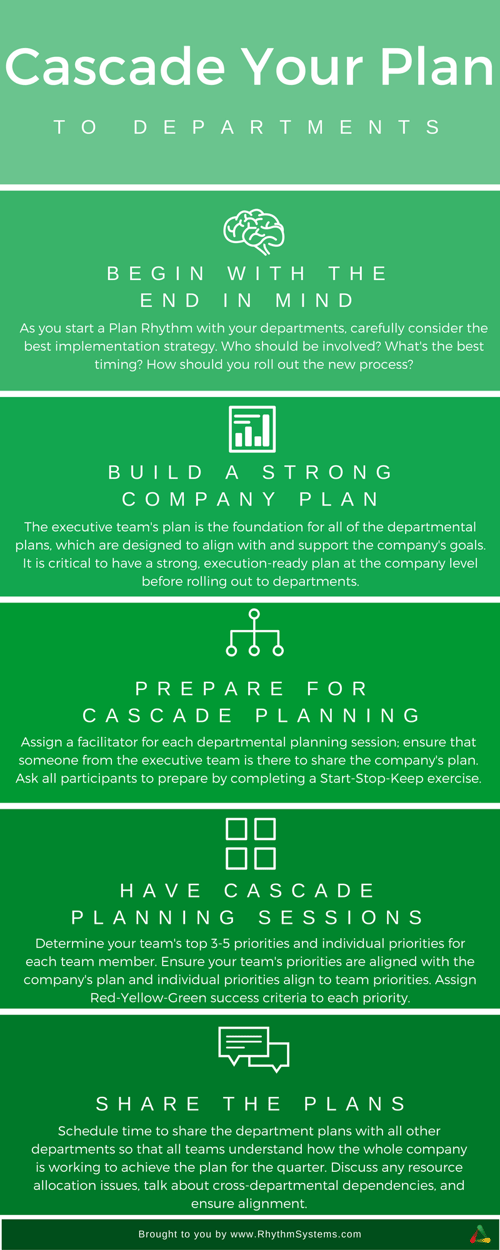At Rhythm Systems, we believe that having a strong Think Plan Do Rhythm is essential to growing your  business with purpose. And, we think this rhythm is key for departments and individuals at every level of the organization, not just for the executive team. Think about how powerful it would be if each and every person in your company could tell you what the top priority for the company was for the year and for the quarter, how success is measured on those priorities, what their team is doing to support achieving those goals, and how they personally are contributing to the company's success. That's why we think cascading the Think Plan Do rhythm to departments is a key step for your company's success.
business with purpose. And, we think this rhythm is key for departments and individuals at every level of the organization, not just for the executive team. Think about how powerful it would be if each and every person in your company could tell you what the top priority for the company was for the year and for the quarter, how success is measured on those priorities, what their team is doing to support achieving those goals, and how they personally are contributing to the company's success. That's why we think cascading the Think Plan Do rhythm to departments is a key step for your company's success.
In theory, this sounds good, right? In reality, we find that some companies get stuck here. We recommend that executive teams spend about a quarter fine tuning their own Think Plan Do rhythm before rolling out our Rhythm methodology to their departments. This way, the team leaders are comfortable with the new habits they've established and feel confident coaching their team to adopt the habits, too. Sure, your teams may already have great execution habits and maybe even healthy meeting rhythms in place. But, until you start a plan rhythm with your departments, how can you know that everyone is executing on the right things? Daily and weekly execution habits that drive the company plan forward hinge on successfully cascading your plan rhythm to your departments. Cascade strategic planning to ensure that all of your departments know what is expected of them - and when - to keep your entire team aligned.
Here's what should be included when Cascading Plans:
Download the infographic here.
Cascade Your Plan to the Departmental level
- Begin with the end in mind. As you start a Plan Rhythm with your departments, carefully consider the best implementation strategy. Who should be involved? What's the best timing? How should you roll out the new process company wide.
- Build a strong company plan. The executive team's plan is the foundation for all of the departmental plans, which are designed to align with and support the company's goals. It is critical to have a strong, execution-ready plan at the company level before rolling it out to departments.
- Prepare for cascade planning. Assign a facilitator for each departmental planning session; ensure that someone from the executive team is there to share the company's plan. Ask all participants to prepare by completing a start stop keep exercise.
- Have cascade planning sessions. Determine you team's top 3-5 priorities and individual priorities for each team member. Ensure your team's priorities are aligned with the company's plan and individual priorities are aligned with the company's plan and individual priorities align to team priorities. Assign Red-Yellow-Green success criteria to each priority.
- Share the plans. Schedule time to share the department plans with all of the other departments so that all teams understand how the whole company is working to achieve the plan for the quarter. Discuss any resource allocation issues, talk about cross-departmental dependencies and ensure alignment.
If you are a Rhythm strategy execution software client, remember that all the detailed resources you need to have a great cascade planning session, including an agenda and a customizable slide deck, are available to you in our Rhythm University help section.
Good luck!
Here is more information on cascading you might find helpful:
Top 3 Things to Decide Before Cascading to Teams
Cascading: KPI Examples for Success Sales Teams
Rhythm Cascade: 5 Ways to Drive Alignment in Your Company
Photo Credit: iStock by Getty Images


